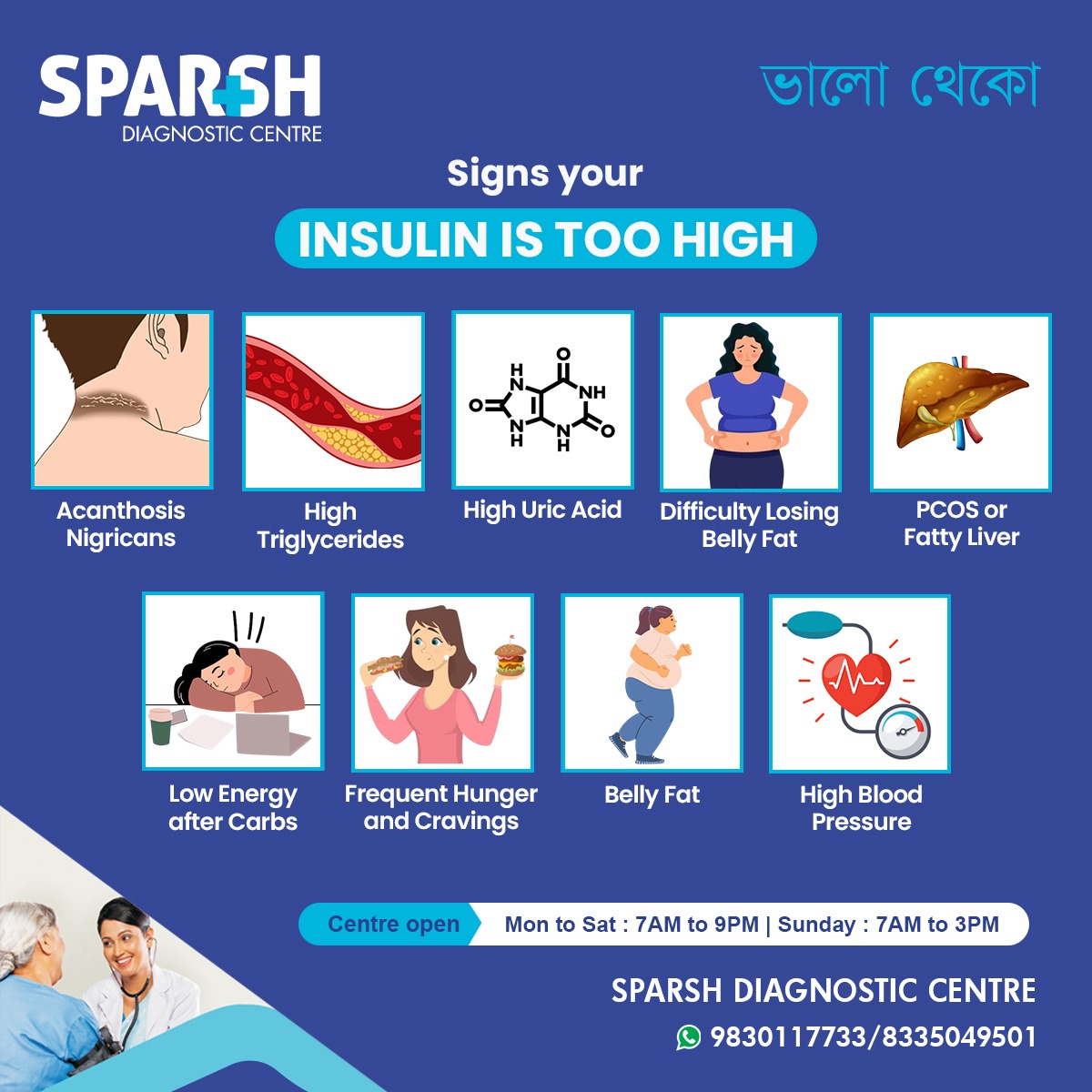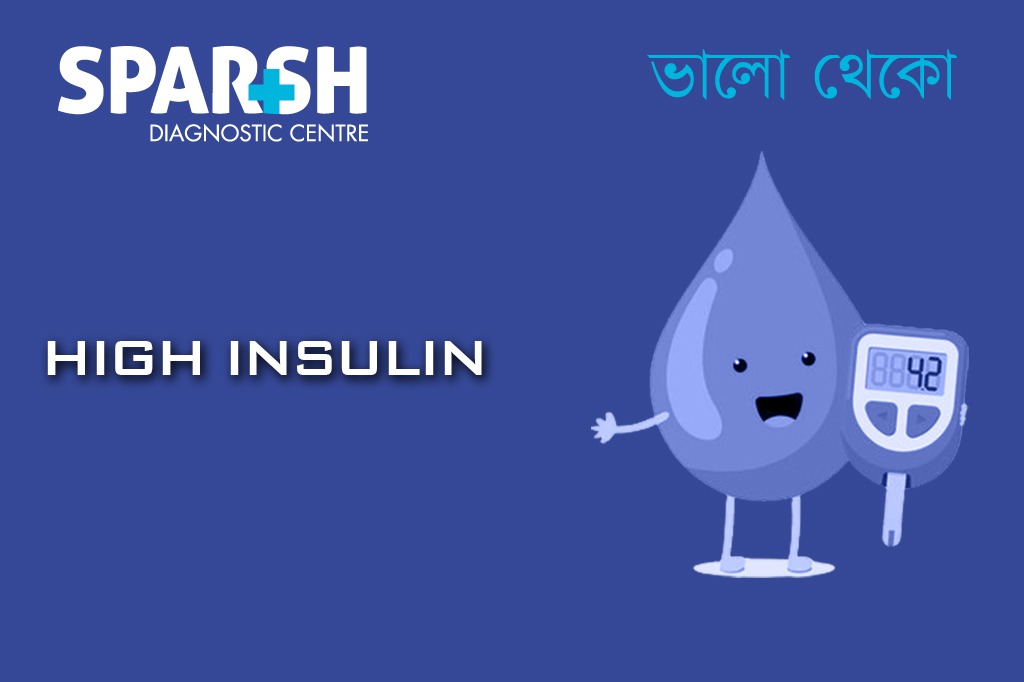Modern day living involves balancing busy work schedules, delicious food, and a fast-paced lifestyle. But amidst this, it’s easy to ignore the subtle warning signs your body gives when something is wrong.
One such warning is high insulin levels, or hyperinsulinemia.
Insulin is a vital hormone that regulates your blood sugar, but when there’s too much of it in your bloodstream, it can set off a chain reaction of health issues — from stubborn belly fat to an increased risk of Type 2 diabetes and heart disease.
The danger? Many people don’t realise their insulin is too high until the problem has already caused significant damage.
At Sparsh Diagnostic Centre in Bansdroni, Kolkata, we help patients detect high insulin early through specialised tests, so you can take control before it’s too late.
Understanding Insulin’s Role
Insulin works like a key, allowing glucose (sugar) from the food you eat to enter your cells for energy. When your body’s insulin is balanced, it keeps your energy steady and your metabolism healthy.
But with too much insulin:
Your body starts storing more fat, especially around your stomach.
Your cells may become resistant to insulin’s effects, leading to insulin resistance.
Over time, this can lead to prediabetes, Type 2 diabetes, metabolic syndrome, and even certain hormone-related disorders.
9 Signs Your Insulin Might Be Too High
Watch for these early warning signs. They’re your body’s way of telling you it’s time to get tested.
1. Acanthosis Nigricans (Dark Skin Patches)
Dark, velvety skin patches on the neck, underarms, or elbows are often linked to high insulin levels. This skin change is caused by insulin’s effect on skin cell growth.
2. High Triglycerides
Excess insulin can increase the amount of triglycerides (a type of fat) in your blood, raising your risk of heart disease.
3. High Uric Acid Levels
Too much insulin can make your kidneys less effective at removing uric acid, increasing your risk of gout.
Example: If you often experience sudden, painful swelling in your big toe or ankle, get your uric acid and insulin tested together.
4. Difficulty Losing Belly Fat
High insulin promotes fat storage in the abdomen. Even strict dieting may not work unless insulin levels are managed.
Sedentary desk jobs and less time for exercise can make belly fat especially stubborn.
5. PCOS or Fatty Liver Disease
Women with high insulin may develop Polycystic Ovary Syndrome (PCOS), leading to irregular periods and fertility issues. High insulin can also contribute to fatty liver disease in both men and women.
6. Fatigue After Carbohydrate-Heavy Meals
Feeling drowsy after eating rice, bread, or sweets can signal an insulin imbalance.
7. Constant Hunger & Cravings
If you feel hungry again shortly after eating, high insulin may be causing rapid drops in blood sugar.
8. Increased Belly Fat Storage
Even without weight gain in other areas, high insulin can specifically lead to increased abdominal fat — a major risk factor for diabetes.
9. High Blood Pressure
Excess insulin can cause your body to retain more sodium, leading to elevated blood pressure.

Insulin Level Tests Available at Sparsh Diagnostic Centre, Bansdroni
Early testing is key to preventing long-term complications. At Sparsh Diagnostic Centre, Bansdroni, we offer:
Fasting Insulin Test – Measures insulin after overnight fasting.
HOMA-IR Test – Calculates insulin resistance.
Oral Glucose Tolerance Test (OGTT) – Tracks blood sugar and insulin response over time.
Lipid Profile – Checks triglycerides and cholesterol.
Liver Function Tests – Detects fatty liver disease.
When to See a Doctor
Seek medical attention if you notice:
Persistent tiredness after meals
Rapid weight gain, especially around your belly
Dark skin patches on your neck or armpits
Unexplained high blood pressure
Irregular menstrual cycles
Managing High Insulin Levels
1. Adjust Your Diet
Cut down on sugary foods and refined carbs.
Eat more whole grains, leafy vegetables, pulses, and lean proteins.
2. Stay Active
Take morning or evening walks.
Include resistance training twice a week to improve insulin sensitivity.
3. Monitor Your Health Regularly
Get periodic blood tests for insulin, blood sugar, and lipids.
Maintain a healthy waist-to-hip ratio.
4. Medical Support
Consult an endocrinologist for medication if lifestyle changes aren’t enough.
High insulin levels are a silent danger, but the signs are there if you pay attention. You don’t need to wait for symptoms to worsen.
At Sparsh Diagnostic Centre, Bansdroni, we provide advanced hormone and metabolic testing to detect problems early — so you can take preventive action before complications arise.
📍 Address: Sparsh Diagnostic Centre, Bansdroni, Kolkata
📞 Phone: 9830117733 / 8335049501
🌐 Website: www.sparshdiagnostica.com
💬 Call to Action: Book your Insulin & Diabetes Risk Assessment today and take the first step toward a healthier future.
#BhaloTheko
Disclaimer:
No content on this site, regardless of date, should ever be used as a substitute for direct medical advice from your doctor or other qualified clinician.

![]()





